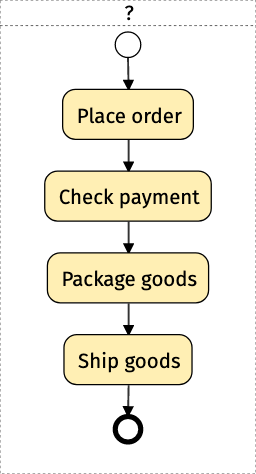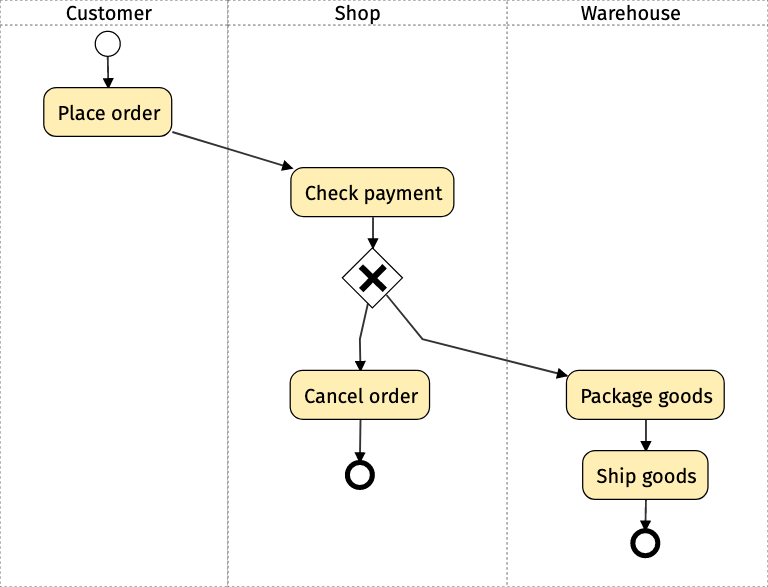Pools and Swimlanes
Pools visually describe the independent entities participating in the collaboration. They capture who is involved in the processes and who is in charge of executing each task.
To associate tasks with the corresponding organization and the specific roles within it, in BPMN tasks are visually located within swimlanes and pools.
In BPMN Sketch Miner, we use task annotations to place individual tasks into swimlanes and pools. It is also possible to specify the default pool for one or more sequences of tasks. We make it easy to enter as little information as possible to place all the tasks of your process into their swimlanes. It is enough to place tasks into their swimlane once: annotate the tasks just the first time you mention them.
Swimlanes are automatically placed together into pools following the rule that control flow handovers must stay within the same pool, while message flow is exchanged across pools.
Pool Task Annotation
If nothing is specified, all tasks are placed within the same pool with only one swimlane named ?.
Let's place the following tasks into pools.
EditPlace order
Check payment
Package goods
Ship goods
You can place tasks in their swimlane by prefixing each line with the name of the swimlane the corresponding task should be placed in. The name of the swimlane and the task label are separated by :
EditCustomer: Place order
Shop: Check payment
Warehouse: Package goods
Ship goods
Note: by default tasks are placed in the same swimlane as their predecessors, so you do not need to annotate all of them, but only tasks which are handed over to another swimlane. Due to the handover between tasks, all swimlanes are placed in the same pool.
It is enough to annotate the swimlane for tasks only the first time a task is mentioned. If a task is repeated in the context of a different swimlane, its swimlane will not change.
EditCustomer: Place order
Shop: Check payment
Warehouse: Package goods
Ship goods
Place order
Check payment
Shop: Cancel order 
Although the Warehouse is the last defined pool before the second time Check payment is mentioned, Check Payment remains in the Shop pool, as it was the pool where it was initially defined. On the other hand, if we do not annotate Cancel order with Shop:, it will be placed in the current pool (the Warehouse).
Default Pool
Setting the default pool or swimlane can save typing some annotations when most of the following tasks are performed by the same default role, with occasional hand-overs to different ones.
To set or change the default for the following tasks, just write the swimlane name (followed by :) on a separate line.
All the tasks listed after setting the default will be assigned to that swimlane, unless annotated with a different swimlane name.
EditCustomer:
Place order
Pay
Receive goods
Shop:
Process order
Check payment
Deliver goods
The default can be overridden by annotating individual tasks to place them in their own swimlane.
EditCustomer:
Place order
Pay
Receive goods
Shop:
Process order
Bank: Check payment
Deliver goods
In the example, the Check payment task is annotated with the Bank swimlane, which overrides the default Shop swimlane, which is used for both Process Order and Deliver goods. The Bank and the Shop swimlanes are placed in the same pool due to the handovers between the tasks of the second sequence.
EditCustomer: Place order
Pay
Receive goods
Shop: Process order
Bank: Check payment
Deliver goods
Without setting a default, the Deliver goods task is placed in the Bank swimlane, as this is the last defined one.
Note: Declaring the default does not break the task sequence. You need a blank line for that.
EditCustomer:
Place order
Pay
Shop:
Process order
Bank: Check payment
Deliver goods
Customer:
Receive goods
Enjoy!
More Examples

